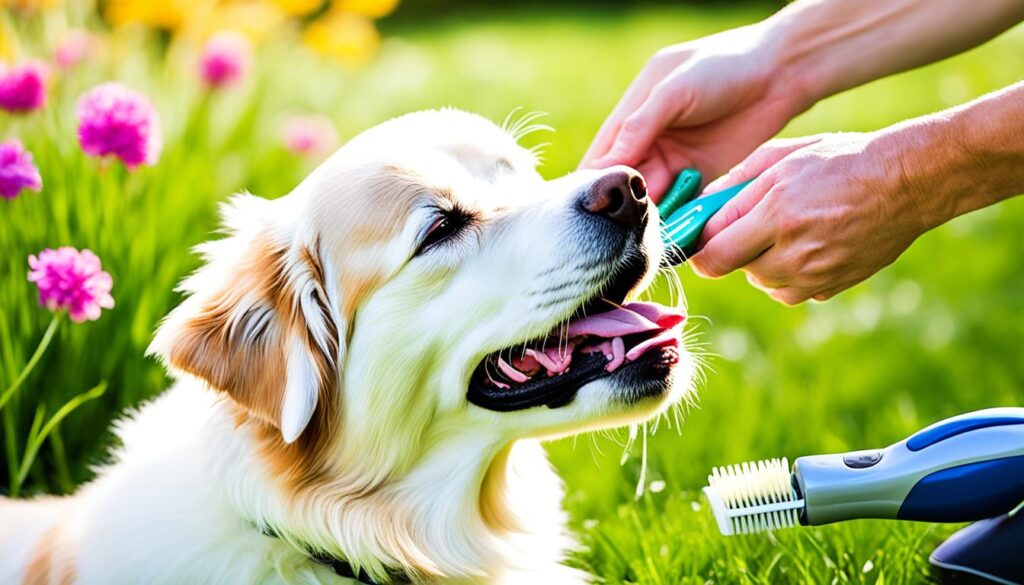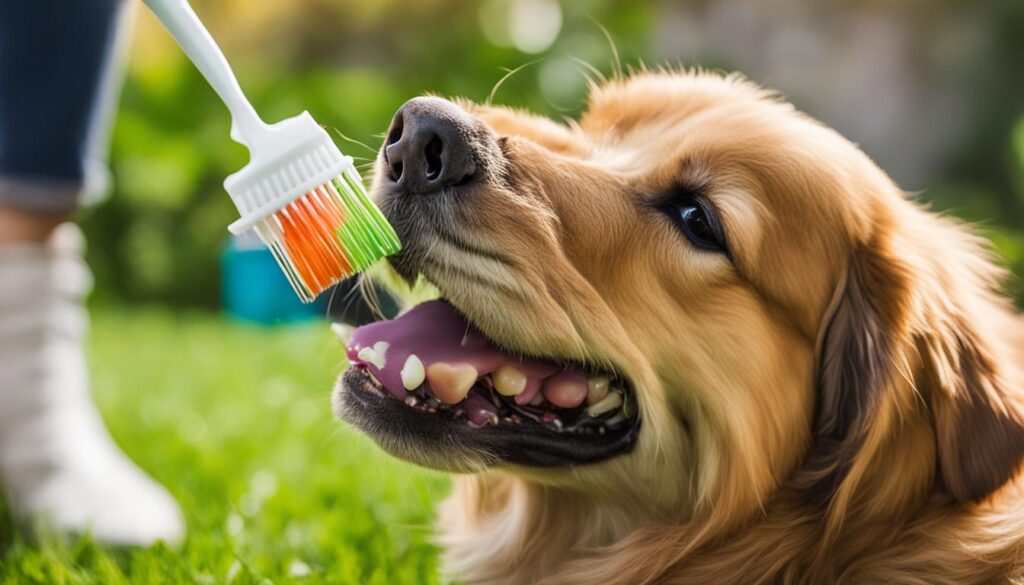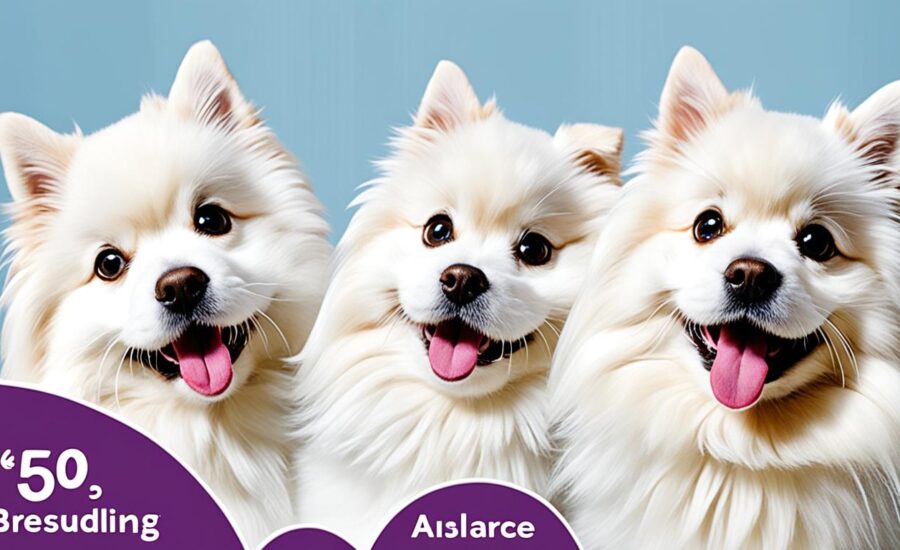Grooming routine for pets might seem like a task just to keep them looking neat. However, this routine activity is key to unlocking 5 Benefits of Regular Brushing for Dogs and Cats. It goes way beyond looks. In exploring pet grooming, we see the importance of pet care. You’ll learn why a simple brushing tool is so powerful for your pet’s well-being and joy.
Key Takeaways
- Uncover hidden health benefits linked to your pet’s regular grooming habit.
- Learn how to use brushing as a detective tool for early health issue detection.
- Grasp the significant role brushing plays in strengthening the pet-owner bond.
- Explore the importance of maintaining a proper brushing frequency.
- Identify the right grooming tools for maximizing your pet’s coat health.
Importance of Pet Care in Maintaining Hygiene and Cleanliness
Keeping your pets clean is more than just about looks—it’s key for their health and your home’s cleanliness. Regular pet grooming helps prevent health issues and guarantees a good life for your pets. We need to look closely at how to keep their coat and surroundings healthy.
Benefits of Bathing in Pet Hygiene
Bathing is a big part of grooming. It’s needed to keep pets clean and safe from bugs or germs. The American Kennel Club suggests a bath every few months to wash off dirt and lower allergen levels. If your pet is very active or has skin issues, they might need more baths. Always use a shampoo made for pets and rinse well to avoid irritation, keeping your pet’s coat healthy.
Impact of Routine Cleaning on Household Environment
Regular pet grooming impacts your pets and your living space. It cuts down on fur, dander, and allergens in your home. This makes your home more comfy, especially for allergy sufferers. It takes a steady grooming routine and planning for your pet’s needs.
Regular Brushing and Allergen Reduction
Brushing your pet often is a top brushing tip for pets to keep your place clean. Brushing 2-3 times a week helps avoid knots, mats, and allergen buildup. This is super important for pets with long or thick fur. Here’s a simple brushing schedule to help keep your pet’s coat healthy:
| Breed Type | Brushing Frequency | Recommended Tools |
|---|---|---|
| Short-haired | Once a week | Grooming mitt, bristle brush |
| Long-haired | Several times a week | Slicker brush, detangling comb |
| Double-coated | 2-3 times a week | Undercoat rake, pin brush |
By following these brushing tips for pets, you improve your pet’s cleanliness and make your home more allergen-free. An effective pet grooming plan is great for their hygiene and strengthens your bond with your pets.
5 Benefits of Regular Brushing for Dogs and Cats
Taking care of your pets goes beyond just giving them baths. It means making pet grooming a part of your everyday activities. The top 5 Benefits of Regular Brushing for Dogs and Cats are key. They don’t just make pets look good, but they have big health benefits too. Let’s look at how regular grooming for pets can make their lives and yours better.
-
Prevention of Painful Matting: Brushing stops fur from tangling and matting. This can cause skin pulls and a lot of pain for your pet.
-
Coat Cleanliness and Shine: By brushing, you’re removing dirt and spreading natural oils. This leaves your pet’s coat clean and shiny.
-
Early Detection of Health Issues: When you brush your pet, you can find bumps or signs of sickness early. This helps in getting them help sooner.
-
Promotion of Nail Health and Comfort: Brushing doesn’t always involve nails, but it often comes together. Keeping nails short stops discomfort and problems walking.
-
Enhancing Emotional Connection: Brushing is calming and helps with bonding. It lowers stress and helps pets trust their owners more.
Understanding the importance of pet care shows us the real value of pet grooming. It’s not just a task, but a vital part of keeping pets happy and healthy. Professional groomers offer valuable help, giving specific care for different breeds. We have a duty to look after our pets’ health and happiness, which makes grooming both important and rewarding.
Promoting Healthy Coats and Skin Detection
For pet owners, a healthy coat for pets and careful skin care is key. A steady pet care routine with regular brushing must be part of daily care. The right pet grooming approach not only gives a shiny coat but also helps find skin problems early.
Let’s see how good brushing habits and the right gear can help your pet’s health and look.

Brushing Techniques for a Lustrous Coat
Starting a routine with the right brushing tips changes everything. It wakes up the follicles, spreading natural skin oils for a bright, healthy coat. Soft, regular brushing also massages the skin, boosting blood flow. This helps your pet’s fur stay lively.
Spotting Skin Anomalies Early
In your pet grooming routine, watch closely for skin changes. Catching lumps, bumps, or unusual spots early means quicker vet care, preventing bigger issues.
Advantages of Using the Right Grooming Tools
Selecting the right grooming tools greatly supports a healthy coat for pets. Diverse breeds need special brushes or combs for their distinct coats. Here’s a guide to pick the best tools:
| Breed Type | Recommended Grooming Tool | Benefits |
|---|---|---|
| Short Hair | Brindle Brush | Removes loose fur, debris, and maintains shine |
| Long Hair | Slicker Brush | Detangles and prevents matting; reaches deeper layers of fur |
| Curly Hair | Wide-Tooth Comb | Gently navigates curls and keeps them intact |
| Double Coat | Undercoat Rake | Thins out undercoat, reduces shedding |
Oral Health and Its Connection to Overall Pet Well-being
The link between oral health for pets and their total well-being can’t be ignored. A strong grooming routine does more than keep their coat shiny. It also fights against dental issues in pets. Good pet health means paying attention to both what we can and can’t see, like dental cleanliness.

Looking after your pet’s teeth can stop periodontal disease. This common issue can hurt them, cause infections, and even make them lose teeth. But, trouble from bad oral care doesn’t stop at the mouth. Harmful bacteria can move from the mouth to harm other parts of the body. This can lead to serious health problems.
Dental care in your pet’s grooming can cut down the risk of these problems. Cleaning their teeth often, and getting them checked by a vet, is key. It’s just as important as feeding them right and making sure they get enough exercise.
- Regularly check your pet’s teeth and gums for signs of disease
- Brush your pet’s teeth daily with pet-safe toothpaste
- Provide dental chews that help reduce tartar and plaque buildup
- Schedule annual dental check-ups with your veterinarian
- Monitor changes in your pet’s eating behavior which may indicate dental discomfort
Pet owners who focus on oral health ensure their pets look good and are truly healthy. So, dental hygiene should always be part of grooming. It shows how much you care.
Pet Dental Health: Avoiding Common Dental Issues in Pets
Taking care of your pet’s teeth is just as important as your dental health. Keeping an eye on pet dental health is key to their overall well-being and helps avoid pet dental issues. Regular grooming should also include care for their teeth, not just their coat and nails. This ensures they stay happy and healthy.
Incorporating Dental Care in Grooming Routines
Adding dental checks to your pet’s grooming can prevent gum disease and other teeth problems. Oral exams should be a routine part, focusing on spotting issues early. This approach is all about being proactive and watchful.
Choosing the Correct Dental Hygiene Products for Your Pet
Using the right products is crucial for your pet’s teeth. Make sure to pick things made for pets, like special toothpaste and the right toothbrush. This makes their dental care safe and effective.
Addressing Periodontal Disease Through Proactive Brushing
Left unchecked, gum disease can seriously affect your pet’s health. Regular brushing can fight plaque and tartar buildup. This helps prevent serious issues from developing due to neglected dental care.
| Dental Issue | Preventive Measure | Products to Consider |
|---|---|---|
| Plaque and Tartar Buildup | Regular Brushing | Enzymatic Toothpaste, Double-Headed Toothbrush |
| Periodontal Disease | Annual Dental Check-ups | Dental Chews, Oral Rinses |
| Bad Breath | Dietary Supplements | Dental Diets, Water Additives |
| Tooth Loss | Chew Toys | Rubber Chew Toys, Dental Care Toys |
Conclusion
Pet grooming is more than just a chore; it’s vital for their health and happiness. The 5 Benefits of Regular Brushing for Dogs and Cats show us that grooming does a lot more. It’s not just about a healthy coat for pets. Brushing can help spot health problems early and is key for pet dental health.
When you make grooming a regular thing, you’re showing how much you care about your pet’s life. This commitment helps prevent sickness and builds a strong bond. As we explore pet grooming, we see it’s about cleanliness, health, and love. Our pets are family, deserving the best care we can give.
Grooming is essential, not just a luxury. It shows we take the importance of pet care seriously, marking us as responsible pet owners. With advice from experts and pet lovers, let’s make every grooming session count. It’s crucial for a pet’s wellbeing, making it a key part of our life with them.
FAQ
What are the top benefits of regular brushing for pets?
How often should pets be bathed and what role does it play in hygiene?
Can regular brushing impact my home’s environment as well?
How does brushing promote a pet’s healthy coat?
What should you look for when choosing brushing tools for pets?
Why is oral health integral to a pet’s overall well-being?
How can you prevent common dental issues in pets?
What are the signs of periodontal disease in pets and how is it addressed?
Source Links
- https://www.linkedin.com/pulse/parkevity-5-surprising-health-benefits-grooming-your-dog-jared-zabel
- https://collegeroadanimalhospital.com/blog/5-essential-benefits-of-grooming-your-pet
- https://thesudsypuppy.net/top-5-benefits-of-regular-dog-grooming/

